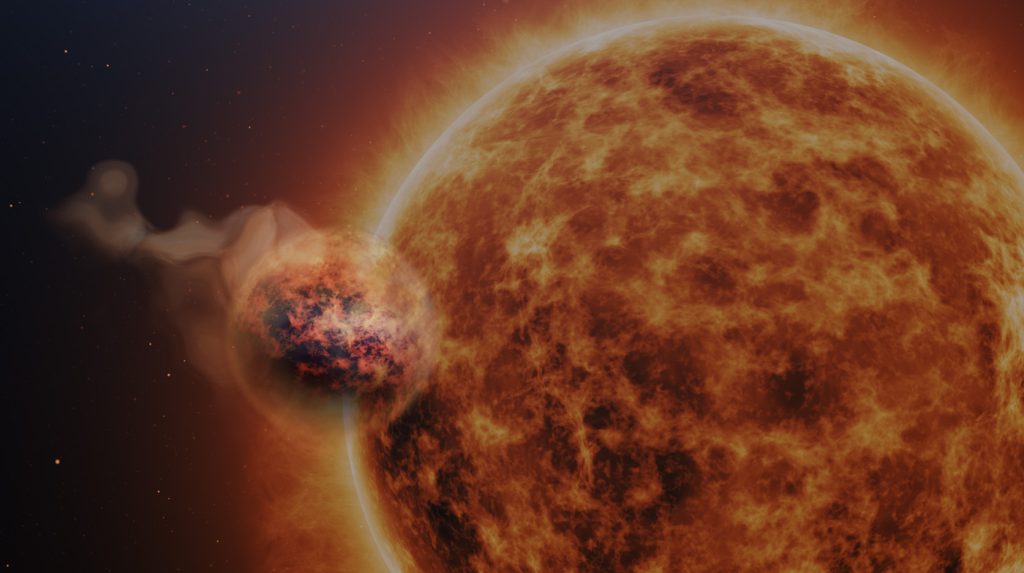Sand Clouds, Water Vapour And Sulphur Dioxide Detected On Nearby Exoplanet Using World-Leading Space Telescope

Science: Achrène Dyrek (CEA and Université Paris Cité, France), Michiel Min (SRON, the Netherlands), Leen Decin (KU Leuven, Belgium) / European MIRI EXO GTO team / ESA / NASA
A University of Leicester space scientist is part of an international team that has discovered ‘sand clouds’ on a planet orbiting a nearby star, using an instrument on the James Webb Space Telescope that University engineers and scientists helped design and develop.
The team of European astronomers used recent observations made with the James Webb Space Telescope (JWST) to study the atmosphere of the nearby exoplanet WASP-107b.
Peering deep into the fluffy atmosphere of WASP-107b they discovered not only water vapour and sulphur dioxide, but even silicate sand clouds. These particles reside within a dynamic atmosphere that exhibits vigorous transport of material. The results of the study appeared today in the prestigious journal Nature.
Astronomers worldwide are harnessing the advanced capabilities of the Mid-Infrared Instrument (MIRI) aboard JWST to conduct groundbreaking observations of exoplanets—planets orbiting stars other than our own Sun.
One of these fascinating worlds is WASP-107b, a unique gaseous exoplanet that orbits a star slightly cooler and less massive than our Sun. The mass of the planet is similar to that of Neptune but its size is much larger, almost approaching the size of Jupiter. This characteristic renders WASP-107b rather ‘fluffy’ when compared to the gas giant planets within our solar system. The fluffiness of this exoplanet enables astronomers to look roughly 50 times deeper into its atmosphere compared to the depth of exploration achieved for a solar-system giant like Jupiter. This opportunity opened a window into unravelling the complex chemical composition of its atmosphere.
The reason behind this is quite straightforward: the signals, or spectral features, are far more prominent in a less dense atmosphere compared to a more compact one. Their recent study, now published in Nature, reveals the presence of water vapour, sulphur dioxide (SO2), and silicate (‘sand-like’) clouds, but notably, there is no trace of the greenhouse gas methane (CH4).
Dr John Pye, Senior Research Fellow in the University of Leicester School of Physics & Astronomy and Space Park Leicester, led a programme of associated observations of the ‘host-star’ around which the exoplanet orbits, in order to monitor the ultraviolet radiation falling on the exoplanet’s atmosphere, an important ingredient in the chemical reactions occurring there. These observations were conducted with NASA’s SWIFT space observatory, in which the University has a prominent role, hosting the UK SWIFT Science Data Centre, which provided expert help in planning the observations. The SWIFT results are also reported in the Nature paper.
Dr Pye said: “Having detailed knowledge of the energy output from the star is important, as this sets the environment within which the exoplanet sits.”
These detections provide crucial insights into the dynamics and chemistry of this captivating exoplanet. First, the absence of methane hints at a potentially warm interior, offering a tantalising glimpse into the movement of heat energy in the planet’s atmosphere. Secondly, the discovery of sulphur dioxide (known for the odour of burnt matches), was a major surprise. Previous models had predicted its absence, but novel climate models of WASP-107b’s atmosphere now show that the very fluffiness of WASP-107b allows the formation of sulphur dioxide in its atmosphere. Even though its host star emits a relatively small fraction of high-energy photons due to its relatively cool temperature, these photons can reach deep into the planet’s atmosphere thanks to its fluffy nature. This enables the chemical reactions required to produce sulphur dioxide to occur.
But that’s not all they’ve observed. Both the spectral features of sulphur dioxide and water vapour are significantly reduced compared to what they would be in a cloudless scenario. High-altitude clouds partially obscure the water vapour and sulphur dioxide in the atmosphere. While clouds have been inferred on other exoplanets, this marks the first instance where astronomers can definitively identify the chemical composition of these clouds. In this case, the clouds consist of small silicate particles, a familiar substance found in many parts of the world as the primary constituent of sand.
Thanks to funding by the UK Space Agency, and the UK Science and Technology Facilities Council, UK engineers and scientists, including those from the University of Leicester, have played a key role in the design and development of the MIRI instrument, and in its testing and calibration, and now in the exploration and analysis of the observations. Engineers and scientists from the University formed part of the teams which tested the MIRI instrument extensively in special test facilities simulating the space environment in the UK, and at NASA Goddard and NASA Johnson Space Centres in the USA.
“Having worked on the JWST-MIRI project for more than 20 years, it’s great now to be involved in these outstanding scientific results,” says Dr Pye.
- These observations were taken as part of the JWST Guaranteed Time Observation program 1280. This finding has been published in the journal Nature ‘SO2, silicate clouds, but no CH4 detected in a warm Neptune’, by Dyrek, Min, Decin et al, 2023, Nature, DOI: 10.1038/s41586-023-06849-0. The co-lead authors are from: CEA and Université Paris Cité, France; SRON Netherlands Institute for Space Research; KU Leuven, Belgium, respectively.
- The James Webb Space Telescope is the world’s premier space science observatory. Webb is solving mysteries in our solar system, looking beyond to distant worlds around other stars, and probing the mysterious structures and origins of our universe and our place in it. Webb is an international program led by NASA with its partners, ESA (European Space Agency) and the Canadian Space Agency.
- The European consortium team consists of 46 astronomers from 29 research institutions across 12 countries. From the University of Leicester, the team includes John Pye, of the School of Physics & Astronomy, and Space Park Leicester.


